Non-Pharmacological Anaesthetic Management of Skin Infections
VerifiedAdded on 2022/11/14
|7
|2227
|358
Report
AI Summary
This report provides a comprehensive overview of non-pharmacological anaesthetic management of bacterial skin infections. It begins with an introduction highlighting the prevalence of skin and skin structure infections, emphasizing the importance of aesthetic management for controlling disease spread. The report delves into the anatomy and physiology of bacterial infections, exploring the body's defense mechanisms and the evolution of antibiotic resistance, which necessitates alternative treatment approaches. It examines the role of aesthetic procedures, such as dermal filler injections, and discusses the significance of patient assessment, infection control, and environmental hygiene. The report outlines recommendations for clinical practices, including skin preparation techniques, the importance of sterile equipment, and aftercare processes. It emphasizes the need for patient consent, awareness of symptoms, and the role of both clinicians and practitioners in effective skin infection management. Finally, it concludes by summarizing the importance of non-medication approaches, risk management, and the critical role of aesthetic management in minimizing skin infections.
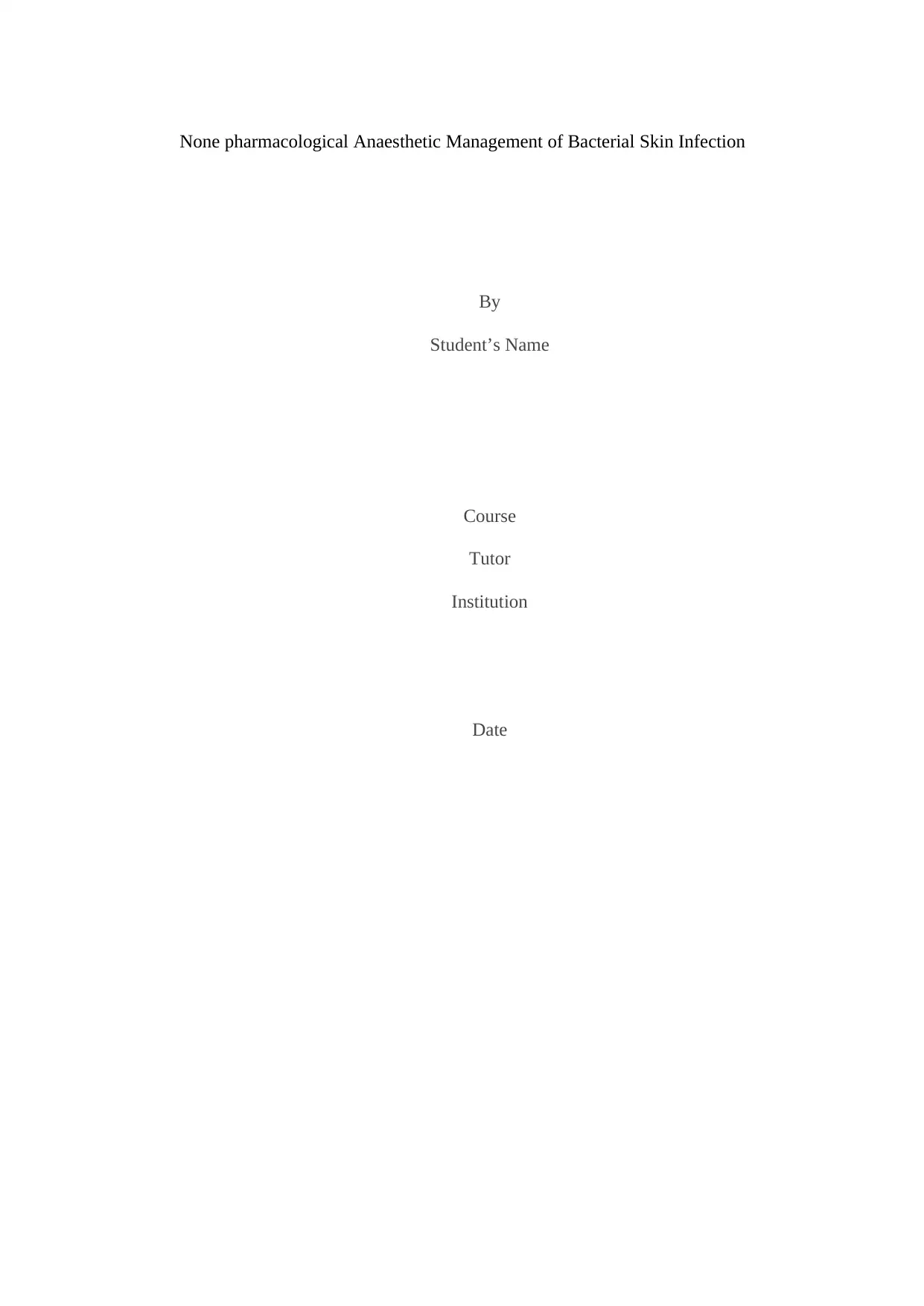
None pharmacological Anaesthetic Management of Bacterial Skin Infection
By
Student’s Name
Course
Tutor
Institution
Date
By
Student’s Name
Course
Tutor
Institution
Date
Paraphrase This Document
Need a fresh take? Get an instant paraphrase of this document with our AI Paraphraser
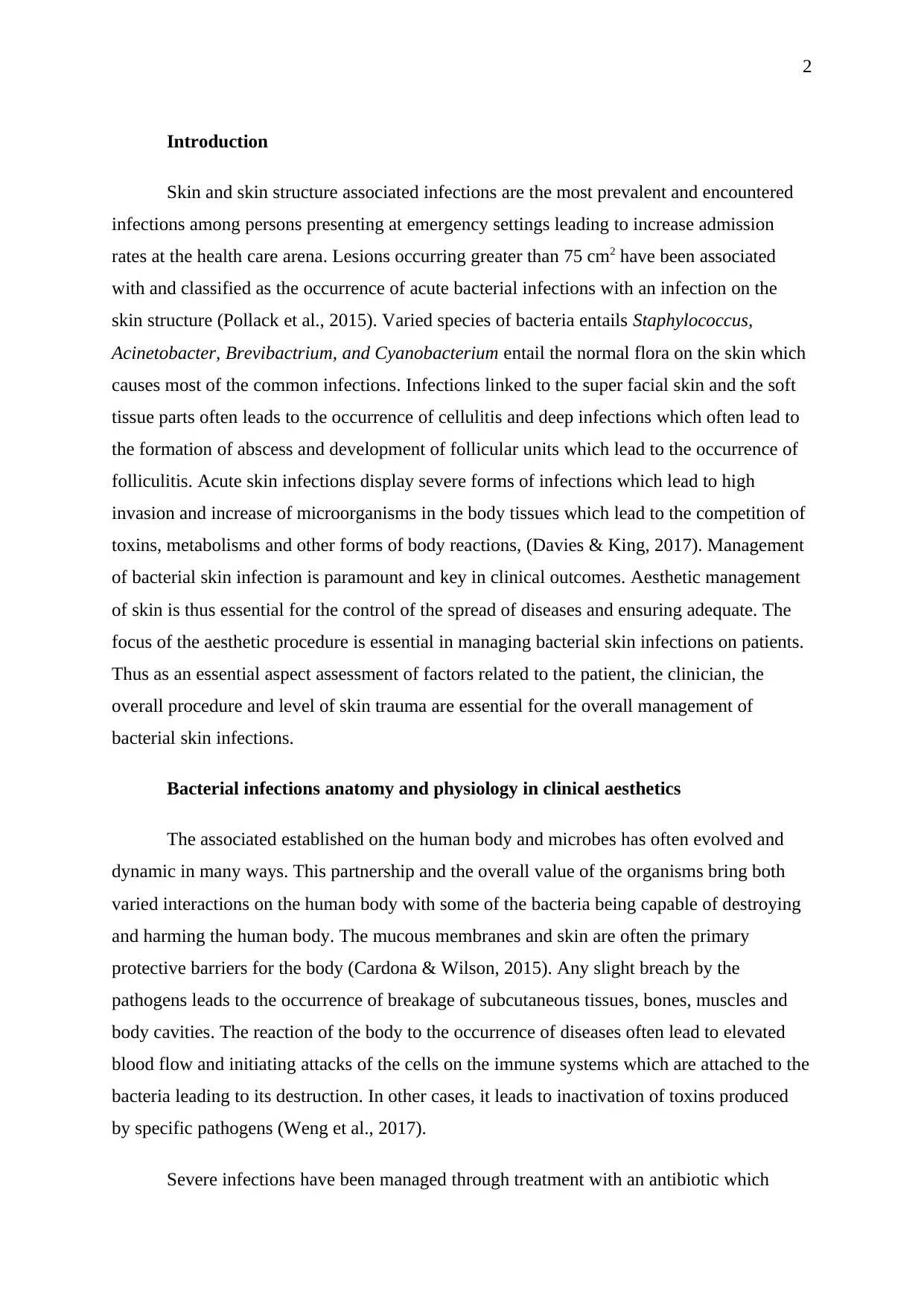
2
Introduction
Skin and skin structure associated infections are the most prevalent and encountered
infections among persons presenting at emergency settings leading to increase admission
rates at the health care arena. Lesions occurring greater than 75 cm2 have been associated
with and classified as the occurrence of acute bacterial infections with an infection on the
skin structure (Pollack et al., 2015). Varied species of bacteria entails Staphylococcus,
Acinetobacter, Brevibactrium, and Cyanobacterium entail the normal flora on the skin which
causes most of the common infections. Infections linked to the super facial skin and the soft
tissue parts often leads to the occurrence of cellulitis and deep infections which often lead to
the formation of abscess and development of follicular units which lead to the occurrence of
folliculitis. Acute skin infections display severe forms of infections which lead to high
invasion and increase of microorganisms in the body tissues which lead to the competition of
toxins, metabolisms and other forms of body reactions, (Davies & King, 2017). Management
of bacterial skin infection is paramount and key in clinical outcomes. Aesthetic management
of skin is thus essential for the control of the spread of diseases and ensuring adequate. The
focus of the aesthetic procedure is essential in managing bacterial skin infections on patients.
Thus as an essential aspect assessment of factors related to the patient, the clinician, the
overall procedure and level of skin trauma are essential for the overall management of
bacterial skin infections.
Bacterial infections anatomy and physiology in clinical aesthetics
The associated established on the human body and microbes has often evolved and
dynamic in many ways. This partnership and the overall value of the organisms bring both
varied interactions on the human body with some of the bacteria being capable of destroying
and harming the human body. The mucous membranes and skin are often the primary
protective barriers for the body (Cardona & Wilson, 2015). Any slight breach by the
pathogens leads to the occurrence of breakage of subcutaneous tissues, bones, muscles and
body cavities. The reaction of the body to the occurrence of diseases often lead to elevated
blood flow and initiating attacks of the cells on the immune systems which are attached to the
bacteria leading to its destruction. In other cases, it leads to inactivation of toxins produced
by specific pathogens (Weng et al., 2017).
Severe infections have been managed through treatment with an antibiotic which
Introduction
Skin and skin structure associated infections are the most prevalent and encountered
infections among persons presenting at emergency settings leading to increase admission
rates at the health care arena. Lesions occurring greater than 75 cm2 have been associated
with and classified as the occurrence of acute bacterial infections with an infection on the
skin structure (Pollack et al., 2015). Varied species of bacteria entails Staphylococcus,
Acinetobacter, Brevibactrium, and Cyanobacterium entail the normal flora on the skin which
causes most of the common infections. Infections linked to the super facial skin and the soft
tissue parts often leads to the occurrence of cellulitis and deep infections which often lead to
the formation of abscess and development of follicular units which lead to the occurrence of
folliculitis. Acute skin infections display severe forms of infections which lead to high
invasion and increase of microorganisms in the body tissues which lead to the competition of
toxins, metabolisms and other forms of body reactions, (Davies & King, 2017). Management
of bacterial skin infection is paramount and key in clinical outcomes. Aesthetic management
of skin is thus essential for the control of the spread of diseases and ensuring adequate. The
focus of the aesthetic procedure is essential in managing bacterial skin infections on patients.
Thus as an essential aspect assessment of factors related to the patient, the clinician, the
overall procedure and level of skin trauma are essential for the overall management of
bacterial skin infections.
Bacterial infections anatomy and physiology in clinical aesthetics
The associated established on the human body and microbes has often evolved and
dynamic in many ways. This partnership and the overall value of the organisms bring both
varied interactions on the human body with some of the bacteria being capable of destroying
and harming the human body. The mucous membranes and skin are often the primary
protective barriers for the body (Cardona & Wilson, 2015). Any slight breach by the
pathogens leads to the occurrence of breakage of subcutaneous tissues, bones, muscles and
body cavities. The reaction of the body to the occurrence of diseases often lead to elevated
blood flow and initiating attacks of the cells on the immune systems which are attached to the
bacteria leading to its destruction. In other cases, it leads to inactivation of toxins produced
by specific pathogens (Weng et al., 2017).
Severe infections have been managed through treatment with an antibiotic which
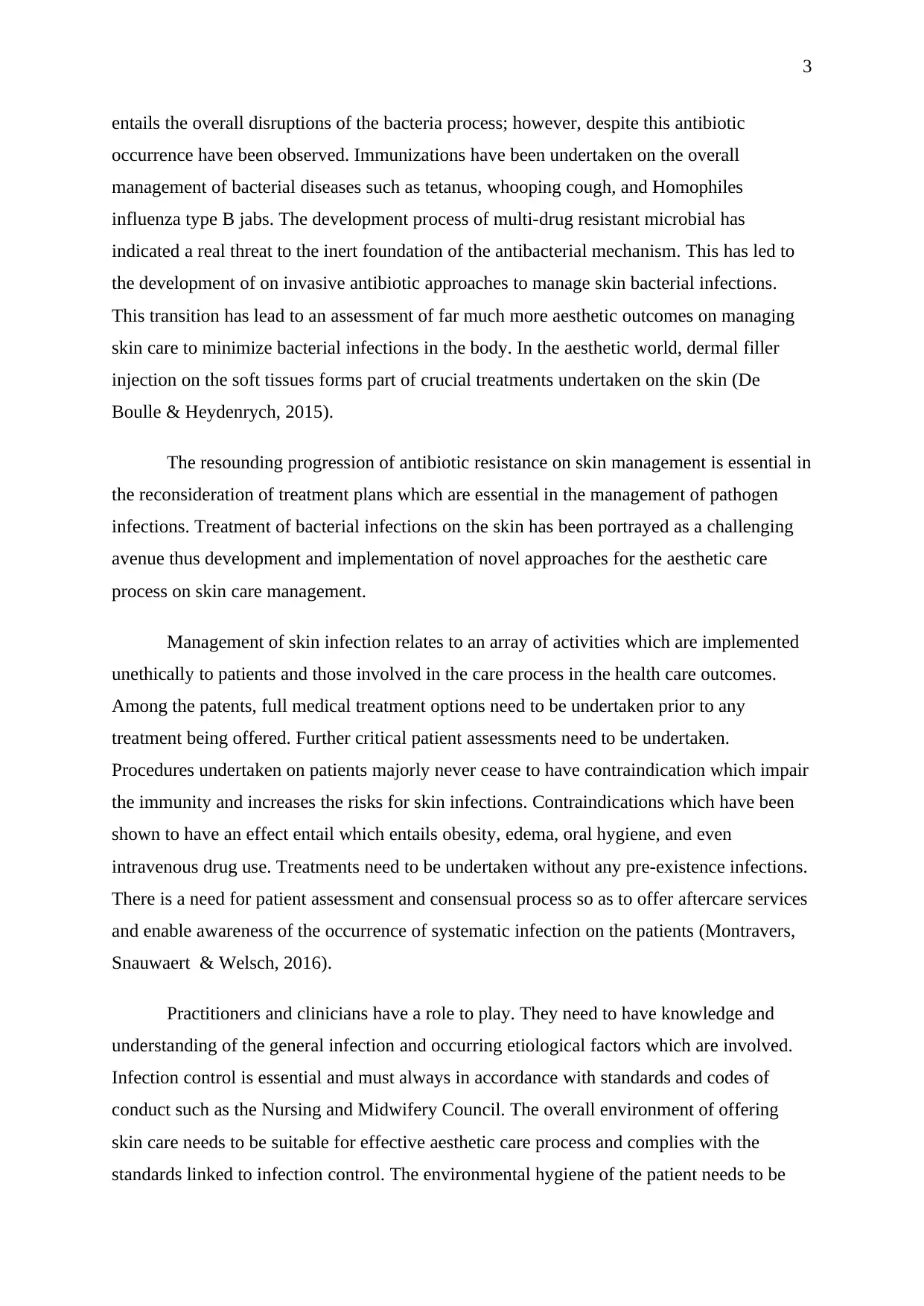
3
entails the overall disruptions of the bacteria process; however, despite this antibiotic
occurrence have been observed. Immunizations have been undertaken on the overall
management of bacterial diseases such as tetanus, whooping cough, and Homophiles
influenza type B jabs. The development process of multi-drug resistant microbial has
indicated a real threat to the inert foundation of the antibacterial mechanism. This has led to
the development of on invasive antibiotic approaches to manage skin bacterial infections.
This transition has lead to an assessment of far much more aesthetic outcomes on managing
skin care to minimize bacterial infections in the body. In the aesthetic world, dermal filler
injection on the soft tissues forms part of crucial treatments undertaken on the skin (De
Boulle & Heydenrych, 2015).
The resounding progression of antibiotic resistance on skin management is essential in
the reconsideration of treatment plans which are essential in the management of pathogen
infections. Treatment of bacterial infections on the skin has been portrayed as a challenging
avenue thus development and implementation of novel approaches for the aesthetic care
process on skin care management.
Management of skin infection relates to an array of activities which are implemented
unethically to patients and those involved in the care process in the health care outcomes.
Among the patents, full medical treatment options need to be undertaken prior to any
treatment being offered. Further critical patient assessments need to be undertaken.
Procedures undertaken on patients majorly never cease to have contraindication which impair
the immunity and increases the risks for skin infections. Contraindications which have been
shown to have an effect entail which entails obesity, edema, oral hygiene, and even
intravenous drug use. Treatments need to be undertaken without any pre-existence infections.
There is a need for patient assessment and consensual process so as to offer aftercare services
and enable awareness of the occurrence of systematic infection on the patients (Montravers,
Snauwaert & Welsch, 2016).
Practitioners and clinicians have a role to play. They need to have knowledge and
understanding of the general infection and occurring etiological factors which are involved.
Infection control is essential and must always in accordance with standards and codes of
conduct such as the Nursing and Midwifery Council. The overall environment of offering
skin care needs to be suitable for effective aesthetic care process and complies with the
standards linked to infection control. The environmental hygiene of the patient needs to be
entails the overall disruptions of the bacteria process; however, despite this antibiotic
occurrence have been observed. Immunizations have been undertaken on the overall
management of bacterial diseases such as tetanus, whooping cough, and Homophiles
influenza type B jabs. The development process of multi-drug resistant microbial has
indicated a real threat to the inert foundation of the antibacterial mechanism. This has led to
the development of on invasive antibiotic approaches to manage skin bacterial infections.
This transition has lead to an assessment of far much more aesthetic outcomes on managing
skin care to minimize bacterial infections in the body. In the aesthetic world, dermal filler
injection on the soft tissues forms part of crucial treatments undertaken on the skin (De
Boulle & Heydenrych, 2015).
The resounding progression of antibiotic resistance on skin management is essential in
the reconsideration of treatment plans which are essential in the management of pathogen
infections. Treatment of bacterial infections on the skin has been portrayed as a challenging
avenue thus development and implementation of novel approaches for the aesthetic care
process on skin care management.
Management of skin infection relates to an array of activities which are implemented
unethically to patients and those involved in the care process in the health care outcomes.
Among the patents, full medical treatment options need to be undertaken prior to any
treatment being offered. Further critical patient assessments need to be undertaken.
Procedures undertaken on patients majorly never cease to have contraindication which impair
the immunity and increases the risks for skin infections. Contraindications which have been
shown to have an effect entail which entails obesity, edema, oral hygiene, and even
intravenous drug use. Treatments need to be undertaken without any pre-existence infections.
There is a need for patient assessment and consensual process so as to offer aftercare services
and enable awareness of the occurrence of systematic infection on the patients (Montravers,
Snauwaert & Welsch, 2016).
Practitioners and clinicians have a role to play. They need to have knowledge and
understanding of the general infection and occurring etiological factors which are involved.
Infection control is essential and must always in accordance with standards and codes of
conduct such as the Nursing and Midwifery Council. The overall environment of offering
skin care needs to be suitable for effective aesthetic care process and complies with the
standards linked to infection control. The environmental hygiene of the patient needs to be
⊘ This is a preview!⊘
Do you want full access?
Subscribe today to unlock all pages.

Trusted by 1+ million students worldwide
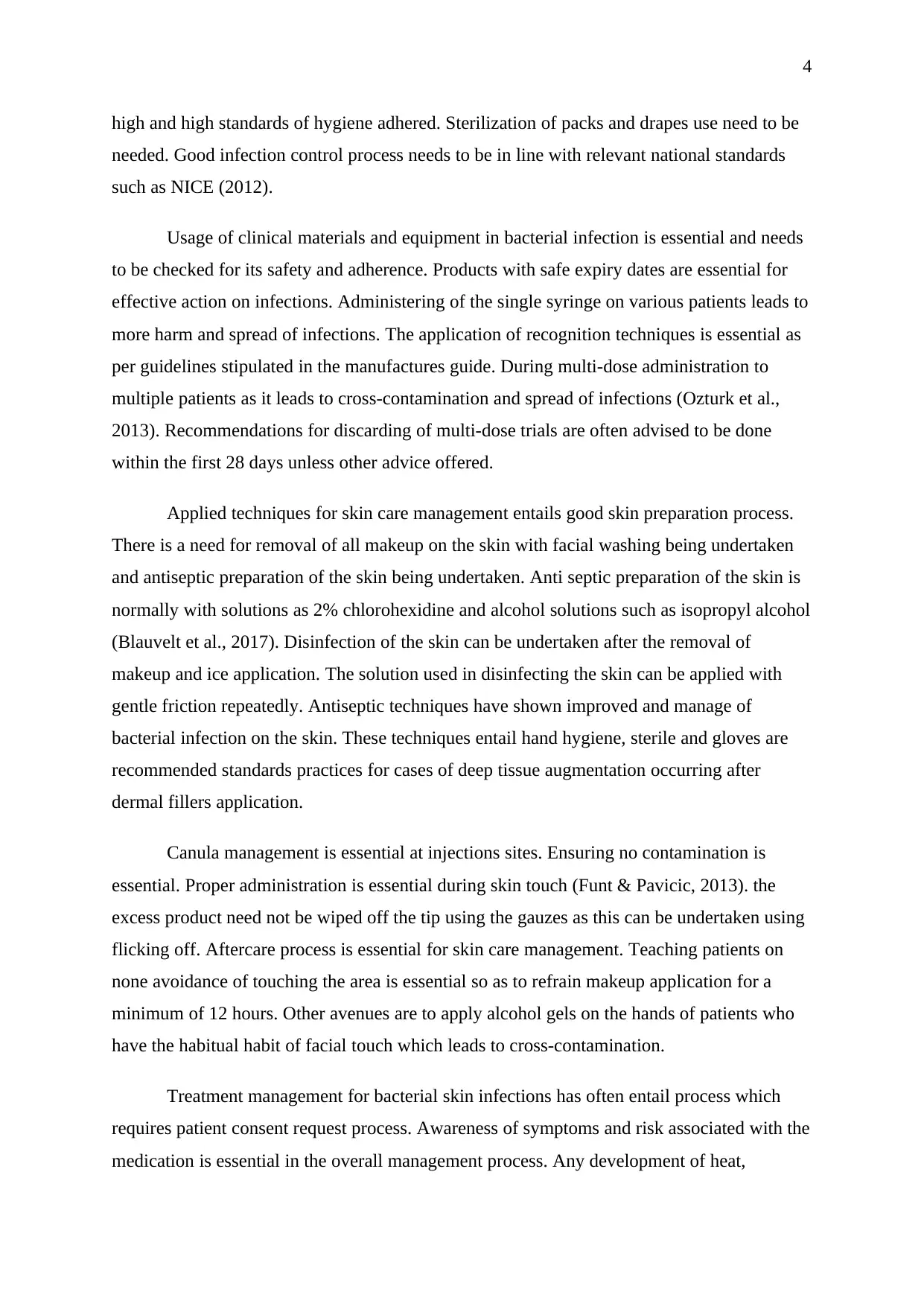
4
high and high standards of hygiene adhered. Sterilization of packs and drapes use need to be
needed. Good infection control process needs to be in line with relevant national standards
such as NICE (2012).
Usage of clinical materials and equipment in bacterial infection is essential and needs
to be checked for its safety and adherence. Products with safe expiry dates are essential for
effective action on infections. Administering of the single syringe on various patients leads to
more harm and spread of infections. The application of recognition techniques is essential as
per guidelines stipulated in the manufactures guide. During multi-dose administration to
multiple patients as it leads to cross-contamination and spread of infections (Ozturk et al.,
2013). Recommendations for discarding of multi-dose trials are often advised to be done
within the first 28 days unless other advice offered.
Applied techniques for skin care management entails good skin preparation process.
There is a need for removal of all makeup on the skin with facial washing being undertaken
and antiseptic preparation of the skin being undertaken. Anti septic preparation of the skin is
normally with solutions as 2% chlorohexidine and alcohol solutions such as isopropyl alcohol
(Blauvelt et al., 2017). Disinfection of the skin can be undertaken after the removal of
makeup and ice application. The solution used in disinfecting the skin can be applied with
gentle friction repeatedly. Antiseptic techniques have shown improved and manage of
bacterial infection on the skin. These techniques entail hand hygiene, sterile and gloves are
recommended standards practices for cases of deep tissue augmentation occurring after
dermal fillers application.
Canula management is essential at injections sites. Ensuring no contamination is
essential. Proper administration is essential during skin touch (Funt & Pavicic, 2013). the
excess product need not be wiped off the tip using the gauzes as this can be undertaken using
flicking off. Aftercare process is essential for skin care management. Teaching patients on
none avoidance of touching the area is essential so as to refrain makeup application for a
minimum of 12 hours. Other avenues are to apply alcohol gels on the hands of patients who
have the habitual habit of facial touch which leads to cross-contamination.
Treatment management for bacterial skin infections has often entail process which
requires patient consent request process. Awareness of symptoms and risk associated with the
medication is essential in the overall management process. Any development of heat,
high and high standards of hygiene adhered. Sterilization of packs and drapes use need to be
needed. Good infection control process needs to be in line with relevant national standards
such as NICE (2012).
Usage of clinical materials and equipment in bacterial infection is essential and needs
to be checked for its safety and adherence. Products with safe expiry dates are essential for
effective action on infections. Administering of the single syringe on various patients leads to
more harm and spread of infections. The application of recognition techniques is essential as
per guidelines stipulated in the manufactures guide. During multi-dose administration to
multiple patients as it leads to cross-contamination and spread of infections (Ozturk et al.,
2013). Recommendations for discarding of multi-dose trials are often advised to be done
within the first 28 days unless other advice offered.
Applied techniques for skin care management entails good skin preparation process.
There is a need for removal of all makeup on the skin with facial washing being undertaken
and antiseptic preparation of the skin being undertaken. Anti septic preparation of the skin is
normally with solutions as 2% chlorohexidine and alcohol solutions such as isopropyl alcohol
(Blauvelt et al., 2017). Disinfection of the skin can be undertaken after the removal of
makeup and ice application. The solution used in disinfecting the skin can be applied with
gentle friction repeatedly. Antiseptic techniques have shown improved and manage of
bacterial infection on the skin. These techniques entail hand hygiene, sterile and gloves are
recommended standards practices for cases of deep tissue augmentation occurring after
dermal fillers application.
Canula management is essential at injections sites. Ensuring no contamination is
essential. Proper administration is essential during skin touch (Funt & Pavicic, 2013). the
excess product need not be wiped off the tip using the gauzes as this can be undertaken using
flicking off. Aftercare process is essential for skin care management. Teaching patients on
none avoidance of touching the area is essential so as to refrain makeup application for a
minimum of 12 hours. Other avenues are to apply alcohol gels on the hands of patients who
have the habitual habit of facial touch which leads to cross-contamination.
Treatment management for bacterial skin infections has often entail process which
requires patient consent request process. Awareness of symptoms and risk associated with the
medication is essential in the overall management process. Any development of heat,
Paraphrase This Document
Need a fresh take? Get an instant paraphrase of this document with our AI Paraphraser
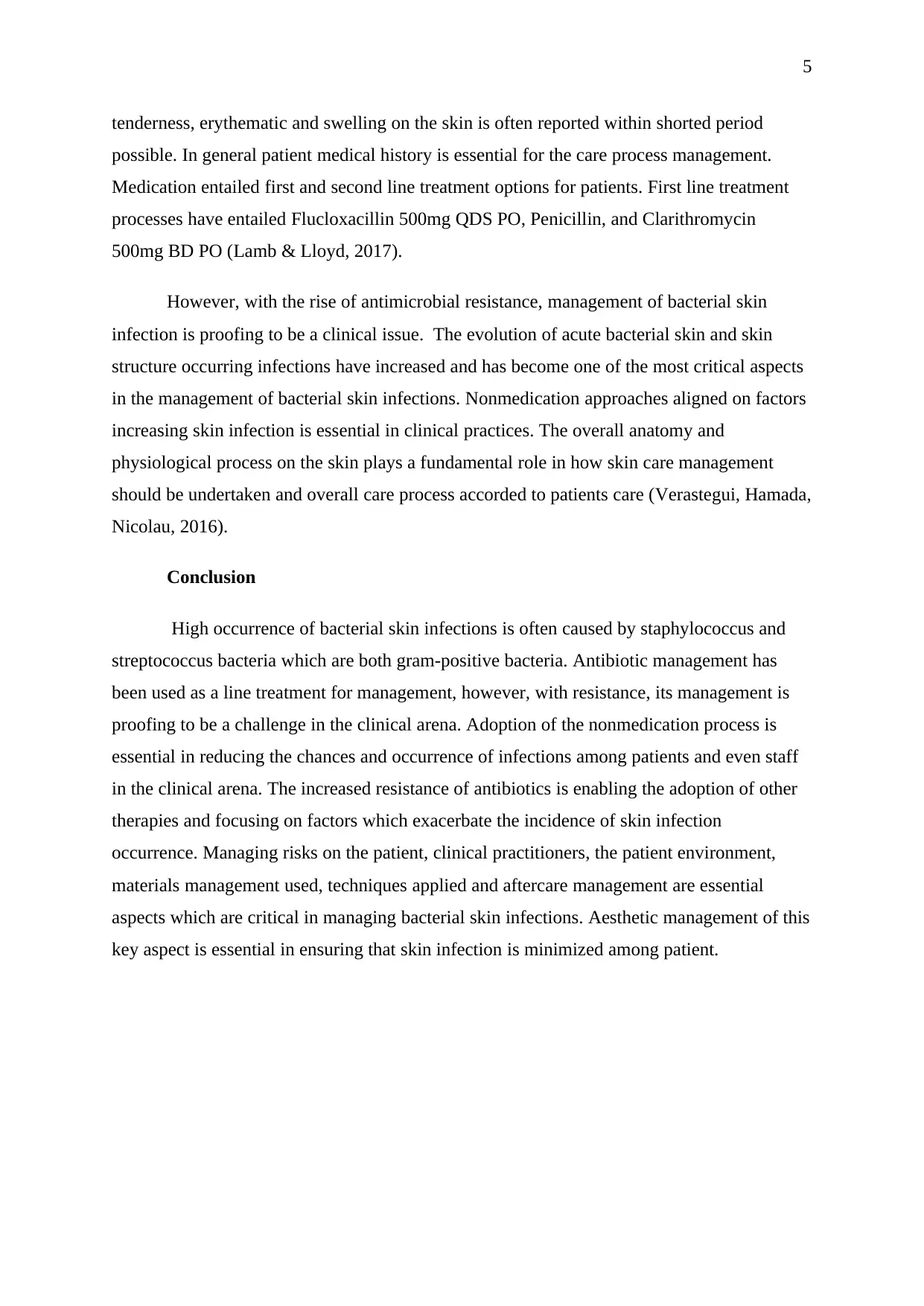
5
tenderness, erythematic and swelling on the skin is often reported within shorted period
possible. In general patient medical history is essential for the care process management.
Medication entailed first and second line treatment options for patients. First line treatment
processes have entailed Flucloxacillin 500mg QDS PO, Penicillin, and Clarithromycin
500mg BD PO (Lamb & Lloyd, 2017).
However, with the rise of antimicrobial resistance, management of bacterial skin
infection is proofing to be a clinical issue. The evolution of acute bacterial skin and skin
structure occurring infections have increased and has become one of the most critical aspects
in the management of bacterial skin infections. Nonmedication approaches aligned on factors
increasing skin infection is essential in clinical practices. The overall anatomy and
physiological process on the skin plays a fundamental role in how skin care management
should be undertaken and overall care process accorded to patients care (Verastegui, Hamada,
Nicolau, 2016).
Conclusion
High occurrence of bacterial skin infections is often caused by staphylococcus and
streptococcus bacteria which are both gram-positive bacteria. Antibiotic management has
been used as a line treatment for management, however, with resistance, its management is
proofing to be a challenge in the clinical arena. Adoption of the nonmedication process is
essential in reducing the chances and occurrence of infections among patients and even staff
in the clinical arena. The increased resistance of antibiotics is enabling the adoption of other
therapies and focusing on factors which exacerbate the incidence of skin infection
occurrence. Managing risks on the patient, clinical practitioners, the patient environment,
materials management used, techniques applied and aftercare management are essential
aspects which are critical in managing bacterial skin infections. Aesthetic management of this
key aspect is essential in ensuring that skin infection is minimized among patient.
tenderness, erythematic and swelling on the skin is often reported within shorted period
possible. In general patient medical history is essential for the care process management.
Medication entailed first and second line treatment options for patients. First line treatment
processes have entailed Flucloxacillin 500mg QDS PO, Penicillin, and Clarithromycin
500mg BD PO (Lamb & Lloyd, 2017).
However, with the rise of antimicrobial resistance, management of bacterial skin
infection is proofing to be a clinical issue. The evolution of acute bacterial skin and skin
structure occurring infections have increased and has become one of the most critical aspects
in the management of bacterial skin infections. Nonmedication approaches aligned on factors
increasing skin infection is essential in clinical practices. The overall anatomy and
physiological process on the skin plays a fundamental role in how skin care management
should be undertaken and overall care process accorded to patients care (Verastegui, Hamada,
Nicolau, 2016).
Conclusion
High occurrence of bacterial skin infections is often caused by staphylococcus and
streptococcus bacteria which are both gram-positive bacteria. Antibiotic management has
been used as a line treatment for management, however, with resistance, its management is
proofing to be a challenge in the clinical arena. Adoption of the nonmedication process is
essential in reducing the chances and occurrence of infections among patients and even staff
in the clinical arena. The increased resistance of antibiotics is enabling the adoption of other
therapies and focusing on factors which exacerbate the incidence of skin infection
occurrence. Managing risks on the patient, clinical practitioners, the patient environment,
materials management used, techniques applied and aftercare management are essential
aspects which are critical in managing bacterial skin infections. Aesthetic management of this
key aspect is essential in ensuring that skin infection is minimized among patient.
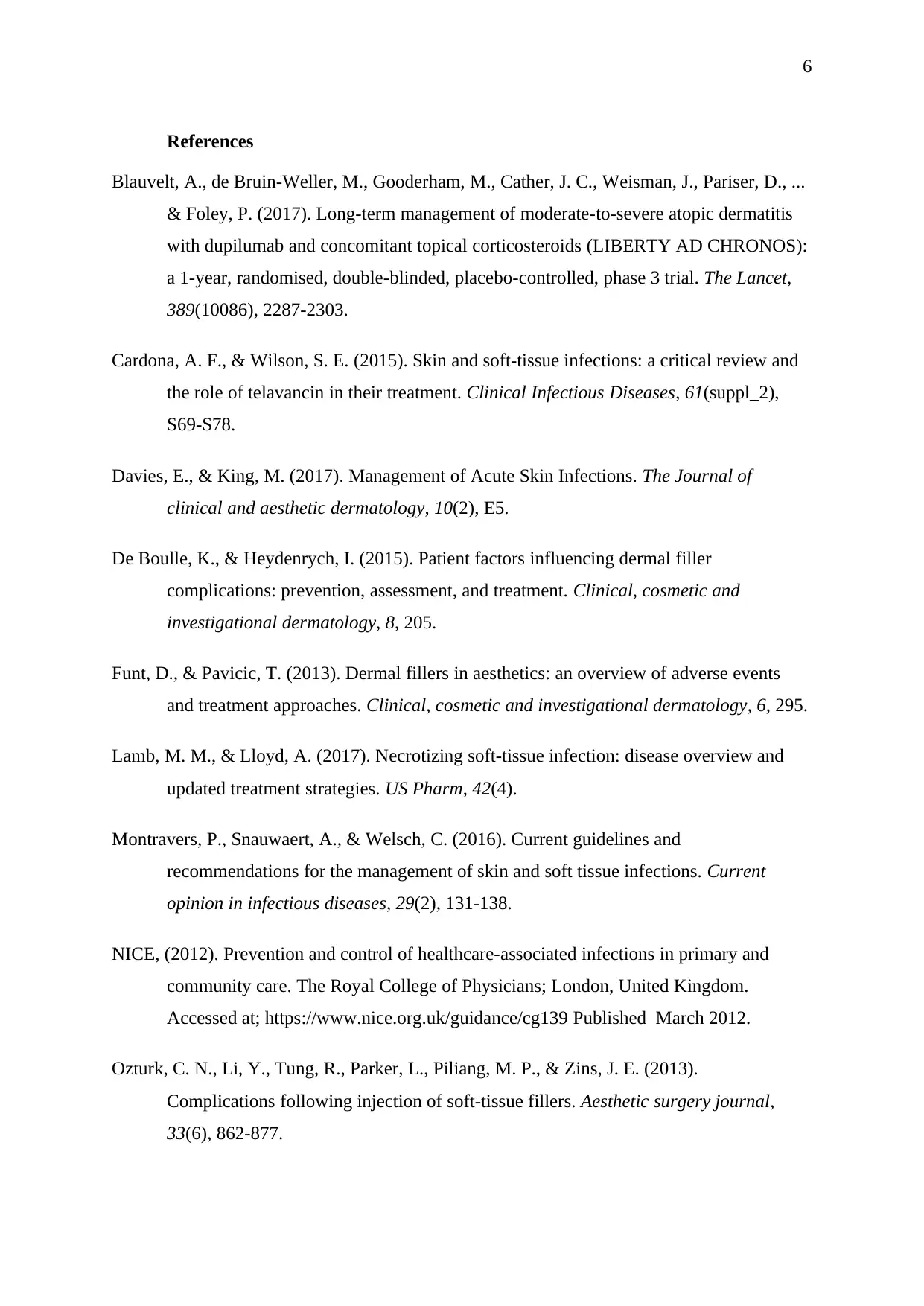
6
References
Blauvelt, A., de Bruin-Weller, M., Gooderham, M., Cather, J. C., Weisman, J., Pariser, D., ...
& Foley, P. (2017). Long-term management of moderate-to-severe atopic dermatitis
with dupilumab and concomitant topical corticosteroids (LIBERTY AD CHRONOS):
a 1-year, randomised, double-blinded, placebo-controlled, phase 3 trial. The Lancet,
389(10086), 2287-2303.
Cardona, A. F., & Wilson, S. E. (2015). Skin and soft-tissue infections: a critical review and
the role of telavancin in their treatment. Clinical Infectious Diseases, 61(suppl_2),
S69-S78.
Davies, E., & King, M. (2017). Management of Acute Skin Infections. The Journal of
clinical and aesthetic dermatology, 10(2), E5.
De Boulle, K., & Heydenrych, I. (2015). Patient factors influencing dermal filler
complications: prevention, assessment, and treatment. Clinical, cosmetic and
investigational dermatology, 8, 205.
Funt, D., & Pavicic, T. (2013). Dermal fillers in aesthetics: an overview of adverse events
and treatment approaches. Clinical, cosmetic and investigational dermatology, 6, 295.
Lamb, M. M., & Lloyd, A. (2017). Necrotizing soft-tissue infection: disease overview and
updated treatment strategies. US Pharm, 42(4).
Montravers, P., Snauwaert, A., & Welsch, C. (2016). Current guidelines and
recommendations for the management of skin and soft tissue infections. Current
opinion in infectious diseases, 29(2), 131-138.
NICE, (2012). Prevention and control of healthcare-associated infections in primary and
community care. The Royal College of Physicians; London, United Kingdom.
Accessed at; https://www.nice.org.uk/guidance/cg139 Published March 2012.
Ozturk, C. N., Li, Y., Tung, R., Parker, L., Piliang, M. P., & Zins, J. E. (2013).
Complications following injection of soft-tissue fillers. Aesthetic surgery journal,
33(6), 862-877.
References
Blauvelt, A., de Bruin-Weller, M., Gooderham, M., Cather, J. C., Weisman, J., Pariser, D., ...
& Foley, P. (2017). Long-term management of moderate-to-severe atopic dermatitis
with dupilumab and concomitant topical corticosteroids (LIBERTY AD CHRONOS):
a 1-year, randomised, double-blinded, placebo-controlled, phase 3 trial. The Lancet,
389(10086), 2287-2303.
Cardona, A. F., & Wilson, S. E. (2015). Skin and soft-tissue infections: a critical review and
the role of telavancin in their treatment. Clinical Infectious Diseases, 61(suppl_2),
S69-S78.
Davies, E., & King, M. (2017). Management of Acute Skin Infections. The Journal of
clinical and aesthetic dermatology, 10(2), E5.
De Boulle, K., & Heydenrych, I. (2015). Patient factors influencing dermal filler
complications: prevention, assessment, and treatment. Clinical, cosmetic and
investigational dermatology, 8, 205.
Funt, D., & Pavicic, T. (2013). Dermal fillers in aesthetics: an overview of adverse events
and treatment approaches. Clinical, cosmetic and investigational dermatology, 6, 295.
Lamb, M. M., & Lloyd, A. (2017). Necrotizing soft-tissue infection: disease overview and
updated treatment strategies. US Pharm, 42(4).
Montravers, P., Snauwaert, A., & Welsch, C. (2016). Current guidelines and
recommendations for the management of skin and soft tissue infections. Current
opinion in infectious diseases, 29(2), 131-138.
NICE, (2012). Prevention and control of healthcare-associated infections in primary and
community care. The Royal College of Physicians; London, United Kingdom.
Accessed at; https://www.nice.org.uk/guidance/cg139 Published March 2012.
Ozturk, C. N., Li, Y., Tung, R., Parker, L., Piliang, M. P., & Zins, J. E. (2013).
Complications following injection of soft-tissue fillers. Aesthetic surgery journal,
33(6), 862-877.
⊘ This is a preview!⊘
Do you want full access?
Subscribe today to unlock all pages.

Trusted by 1+ million students worldwide
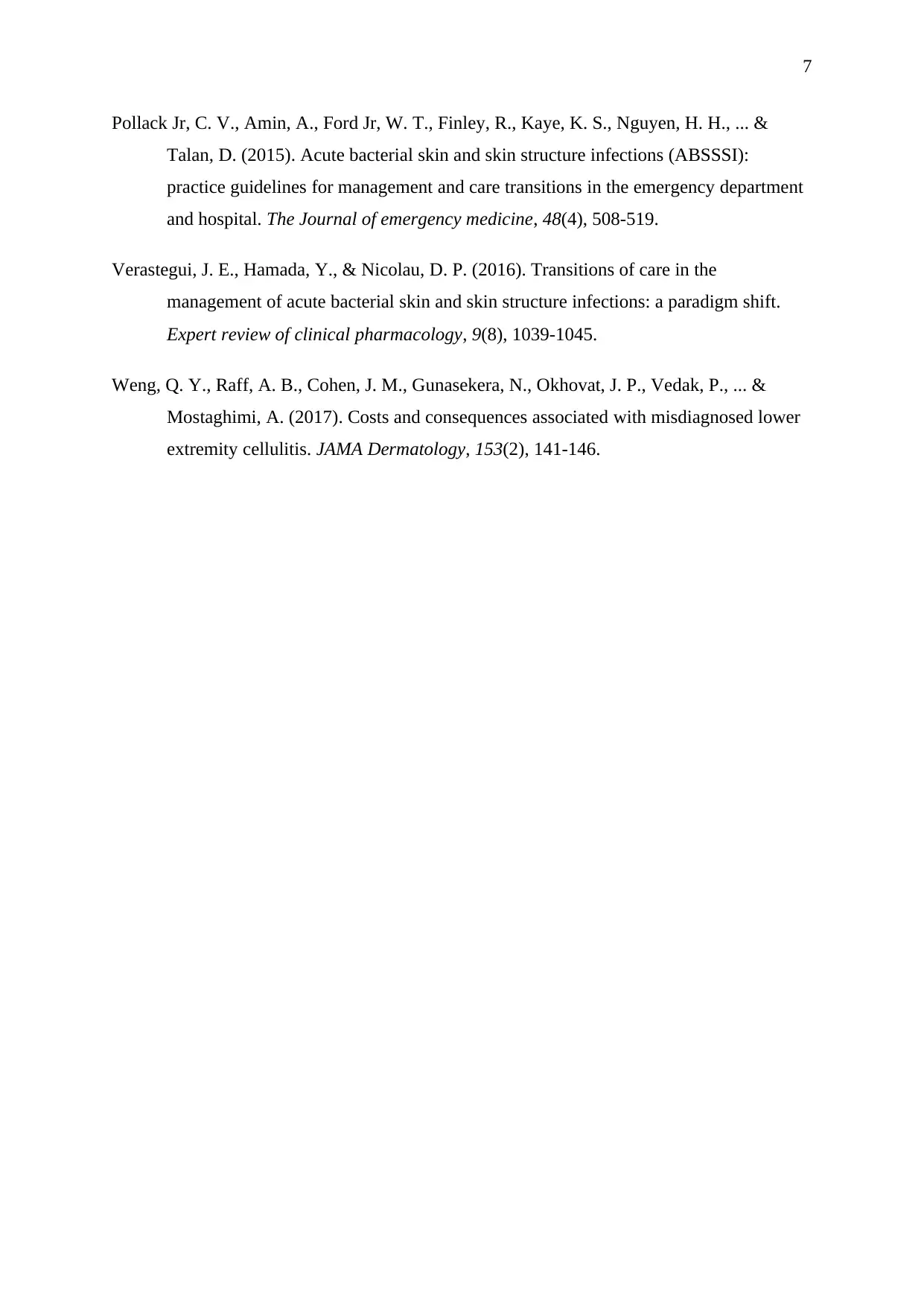
7
Pollack Jr, C. V., Amin, A., Ford Jr, W. T., Finley, R., Kaye, K. S., Nguyen, H. H., ... &
Talan, D. (2015). Acute bacterial skin and skin structure infections (ABSSSI):
practice guidelines for management and care transitions in the emergency department
and hospital. The Journal of emergency medicine, 48(4), 508-519.
Verastegui, J. E., Hamada, Y., & Nicolau, D. P. (2016). Transitions of care in the
management of acute bacterial skin and skin structure infections: a paradigm shift.
Expert review of clinical pharmacology, 9(8), 1039-1045.
Weng, Q. Y., Raff, A. B., Cohen, J. M., Gunasekera, N., Okhovat, J. P., Vedak, P., ... &
Mostaghimi, A. (2017). Costs and consequences associated with misdiagnosed lower
extremity cellulitis. JAMA Dermatology, 153(2), 141-146.
Pollack Jr, C. V., Amin, A., Ford Jr, W. T., Finley, R., Kaye, K. S., Nguyen, H. H., ... &
Talan, D. (2015). Acute bacterial skin and skin structure infections (ABSSSI):
practice guidelines for management and care transitions in the emergency department
and hospital. The Journal of emergency medicine, 48(4), 508-519.
Verastegui, J. E., Hamada, Y., & Nicolau, D. P. (2016). Transitions of care in the
management of acute bacterial skin and skin structure infections: a paradigm shift.
Expert review of clinical pharmacology, 9(8), 1039-1045.
Weng, Q. Y., Raff, A. B., Cohen, J. M., Gunasekera, N., Okhovat, J. P., Vedak, P., ... &
Mostaghimi, A. (2017). Costs and consequences associated with misdiagnosed lower
extremity cellulitis. JAMA Dermatology, 153(2), 141-146.
1 out of 7
Related Documents
Your All-in-One AI-Powered Toolkit for Academic Success.
+13062052269
info@desklib.com
Available 24*7 on WhatsApp / Email
![[object Object]](/_next/static/media/star-bottom.7253800d.svg)
Unlock your academic potential
Copyright © 2020–2025 A2Z Services. All Rights Reserved. Developed and managed by ZUCOL.





